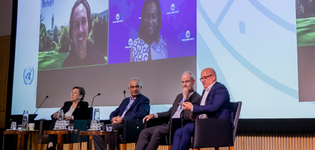Blog
From conflict preventor to security actor
European Peace Facility, Ukraine, and the evolution of EU’s role
Russia’s war of aggression on Ukraine has catalysed the European Union (EU) — criticised as a paper tiger yet acknowledged to evolve through crises — to take concrete steps in security and defence action. The new European Peace Facility (EPF) will now be used to finance lethal equipment for the Ukrainian army. The decision is an historic step for the EU. While unprecedented, the move reflects a long-felt need within the bloc to take better care of Europe’s security.
The EU is traditionally understood as a key civilian partner of the United Nations in supporting conflict prevention, crisis management, and peaceful conflict resolution. Since the Gothenburg programme defined the EU’s approach to conflict prevention in 2001, the EU has developed considerable capabilities with regard to institutional civilian conflict prevention and peacebuilding, including early warning capabilities and financing mechanisms.
Amid the diverging strategic interests of its member states, and due to the prioritization of the NATO framework in defence matters, the EU’s military power and defence agency have been conceived as weak in practice. EU Common Security and Defence Policy (CSDP) operations and missions are mostly civilian (11 ongoing), whilst the Union has also undertaken 14 military crisis management missions (focused on training and capacity-building) over the past 20 years (seven ongoing).
A sudden shift?
Against this backdrop, the steps taken by the EU and its member states since Russia’s war on Ukraine started — such as breaking of the taboo against arms provision — may seem drastic and sudden. While unprecedented, these measures follow a gradual shift in the EU’s Common Foreign and Security Policy (CFSP) mindset. The evolving mindset is related to changes in the security environment around the EU and a shifting international order in which US attention to Europe fluctuates more than before.
The need to ‘speak the language of power’ is already implicit in the EU Global Strategy (2016), published days after the Brexit vote and only months before Donald Trump took power in the United States. Since then, the EU has taken steps — for instance, through the defence cooperation frameworks PESCO and the EDF — to strengthen its security and defence agency. Most recent efforts in this realm will culminate in the EU’s Strategic Compass, slated for publication later this month.
The European Peace Facility is a clear example of EU's efforts to strengthen its credibility and geopolitical leverage, with implications for conflict-affected states around the world. The EPF is an off-budget instrument presented as a tool to increase the EU’s ‘ability to prevent conflicts and strengthen international peace and security’. First introduced in 2018 and adopted in March 2021, it demonstrates EU member states’ desire to improve the EU’s effectiveness as a security partner.
In practice, the new instrument funds EU military operations’ common costs, and military and defence-related assistance to third parties. It broadens the EU’s ability to support conflict-affected states. It both expands the number of recipients eligible for support and enables the provision of lethal equipment to partners for the first time in history. The facility also allows for the ‘constructive abstention’ of member states as a way to overcome typical bottlenecks in EU decision-making.
Not without controversy
Notably, the adoption of the EPF was heavily criticized by both civil society and experts on conflict and peacebuilding dynamics. Beyond opposition to militarization of the EU (at the expense of its civilian structural and operational conflict prevention), major concerns centred on the potential unintended consequences of arms provision to parties in complex conflict contexts. Experiences from Afghanistan and the Sahel, for example, suggest that focusing on capacity-building, training, and equipping security forces where societal trust and social cohesion are weak can be ineffective and even counterproductive (for human security).
In Ukraine, the EPF is now being used in a context that undoubtedly few of its advocates or critics anticipated. Rather than providing lethal equipment to a partner state countering non-state armed groups, Ukraine is resisting a full-scale military invasion by another country. It is also perceived as a matter of direct relevance to EU security. This can be considered less controversial than EPF support to state partners in conflict with non-state actors in contexts where the state’s own role in providing (in)security is often deeply controversial. Therefore, it also seemingly justifies the preceded investments in hard security and defence capabilities in the EU.
What comes next?
While the decision to provide lethal materiel to Ukraine is generally deemed justified, the original risks with the EPF have not disappeared and need to be reconsidered carefully whenever using the tool.
In fact, it could be unwise to take the EPF’s use in Ukraine as a precedent or a guideline for its future use to provide lethal materiel. In particular, the short timeframe in which decisions have been made raises questions concerning the extent of the risk and impact assessments carried out. While the urgency of the situation necessitated rapid reaction, a thorough risk assessment is a key demand of experts concerned about how the facility will be used, as per EU committment. On the other hand, the context in which the lethal materiel is now provided might give a sense of clarity and normative purpose for the EU’s militarised engagements as a security actor - implying a high threshold for the use of the provision.
More broadly speaking, the continued evolution of the EU’s hard security capabilities will also shape how the EU performs its more traditional civilian conflict prevention and peacebuilding role. Research suggests that the EU’s internal security priorities (and geopolitical objectives) are increasingly motivating support to third parties. This is concerning as efforts to strengthen security do not automatically translate to conflict resolution and peacebuilding.
As the EU gains momentum as a security actor, it ought to remember what ultimately makes it stand out (both at home and as a partner) — its (imperfect) commitment to societal peace, democratic governance, and human rights, and systematic support towards these goals around the world.
Dr Katariina Mustasilta is a Leading Researcher in the EU Research Programme of the Finnish Institute of International Affairs (FIIA). Her upcoming article ‘Preventing What for Whom?: EU Conflict Prevention Efforts Amid Pursuit of Autonomy’ examines the EU’s conflict prevention efforts amid the bloc’s pursuit of a more credible security and defence agency (forthcoming in the European Foreign Affairs Review).
Tyyne Karjalainen is a Research Fellow in the EU Research Programme of the Finnish Institute of International Affairs (FIIA). She is the first author of the recently published FIIA Analysis on the EU’s strategic approach to CSDP interventions.
The views expressed in this piece are those of the author(s), and do not necessarily reflect the views of the Institute or the United Nations University, nor the programme/project donors.
 Join the network
Join the network

















